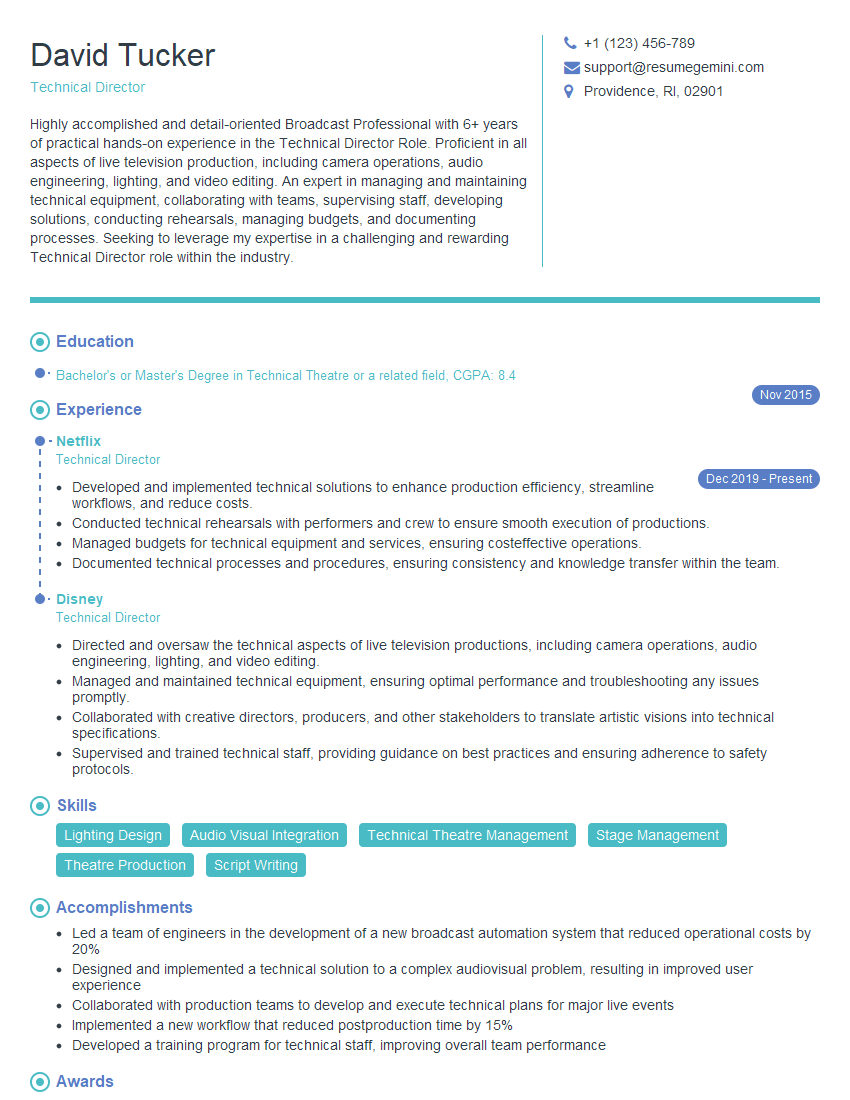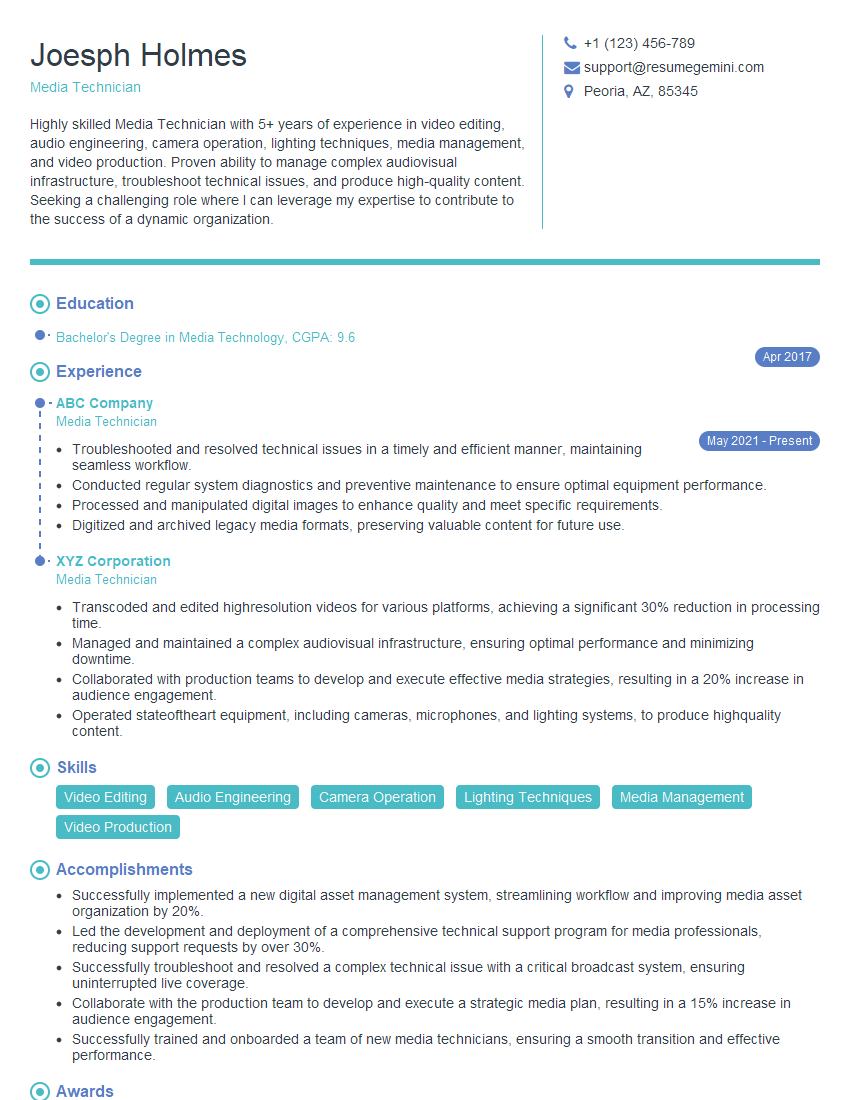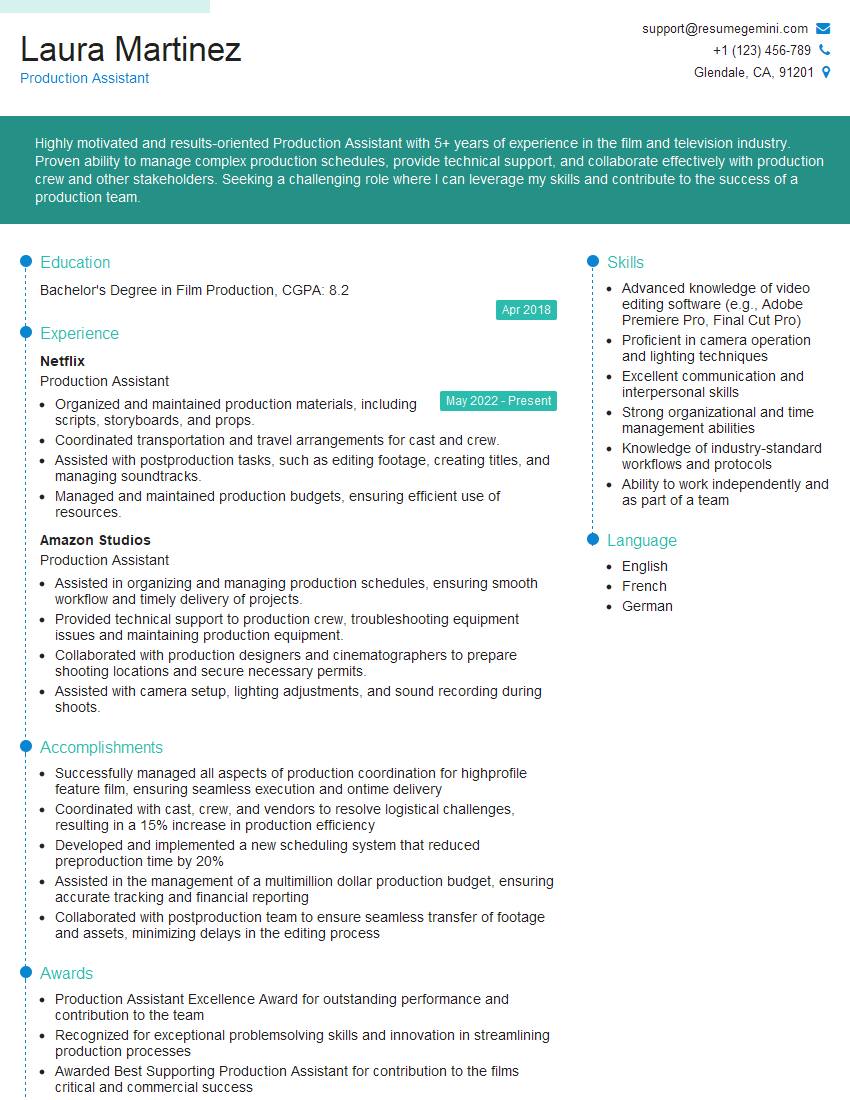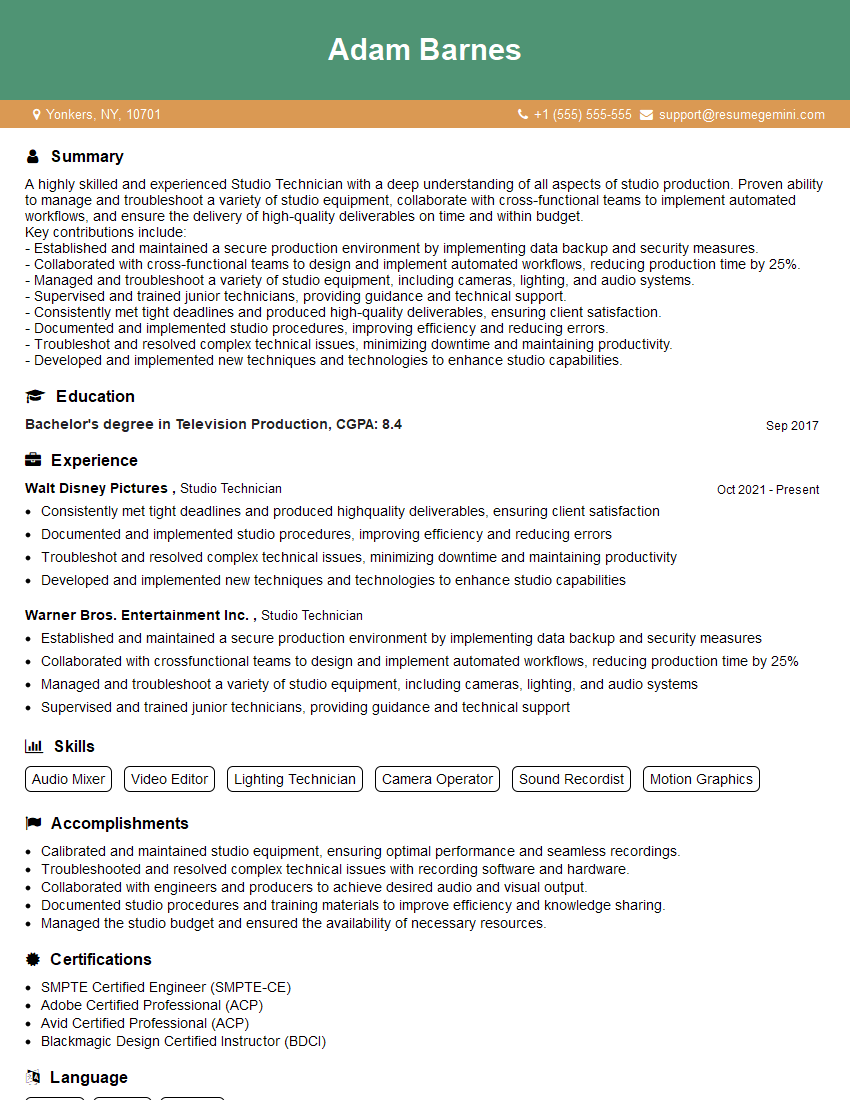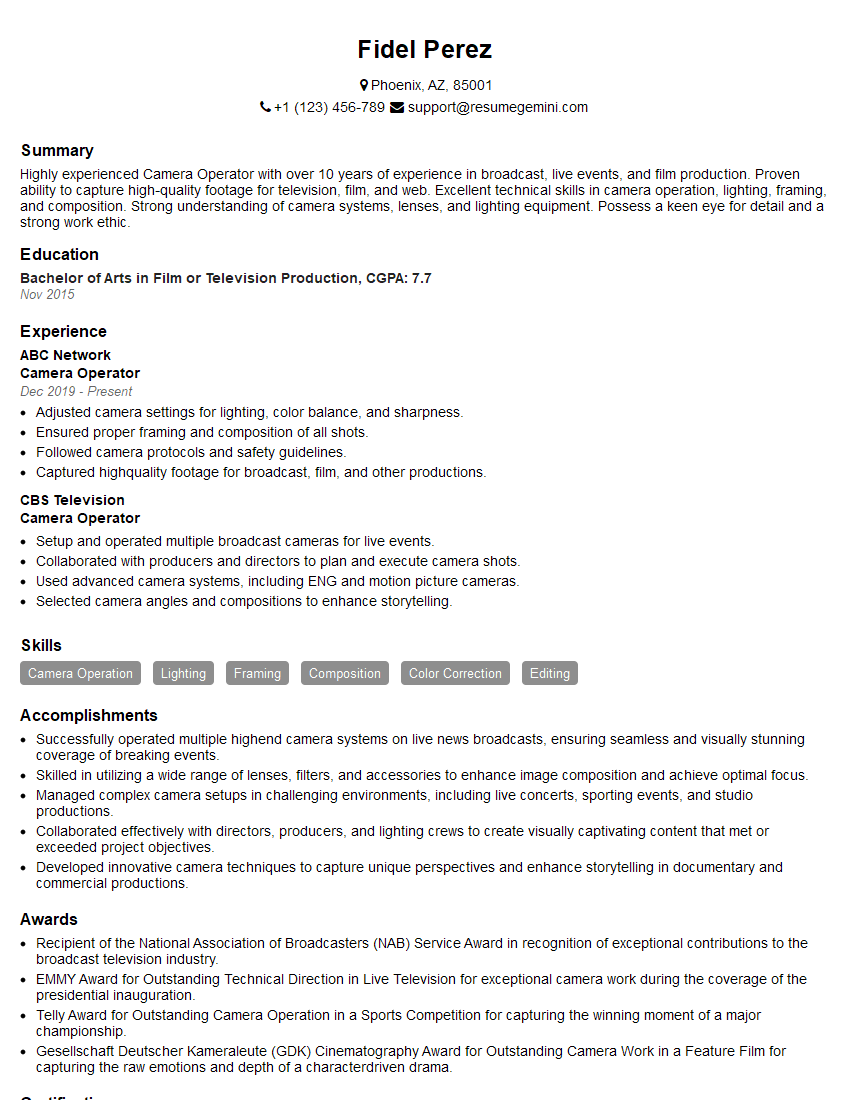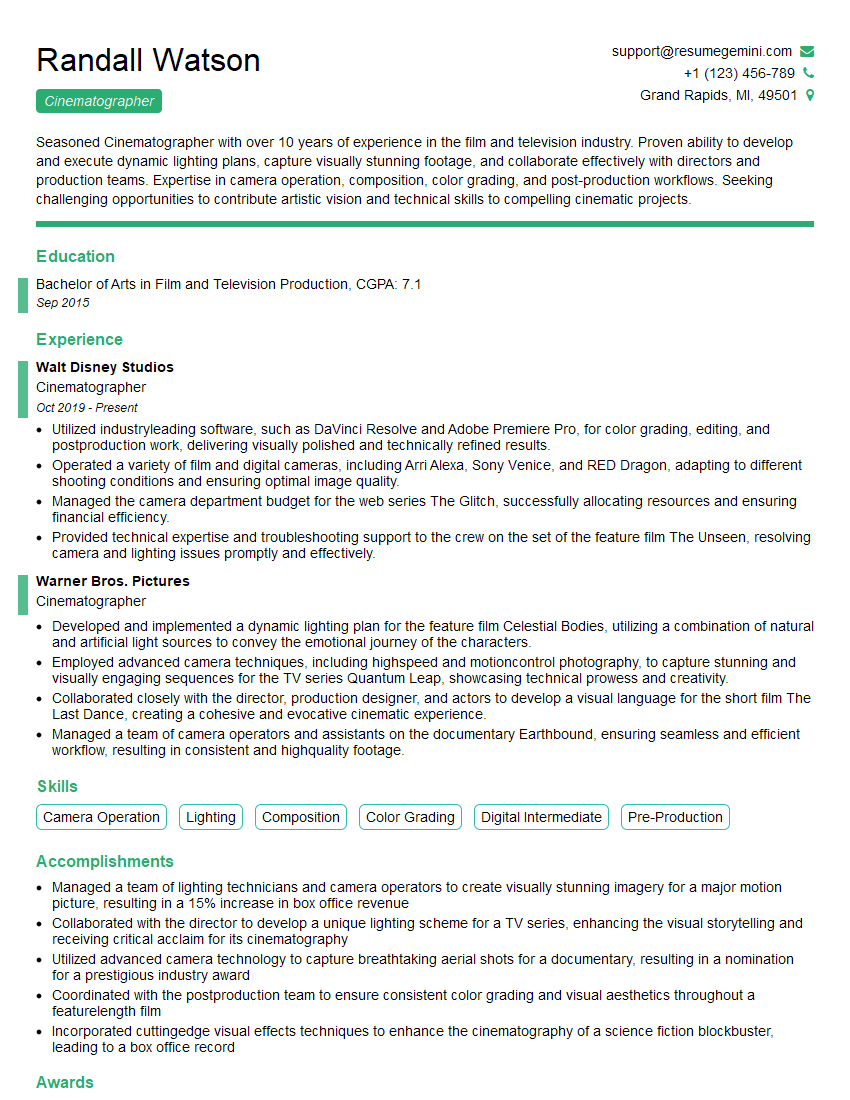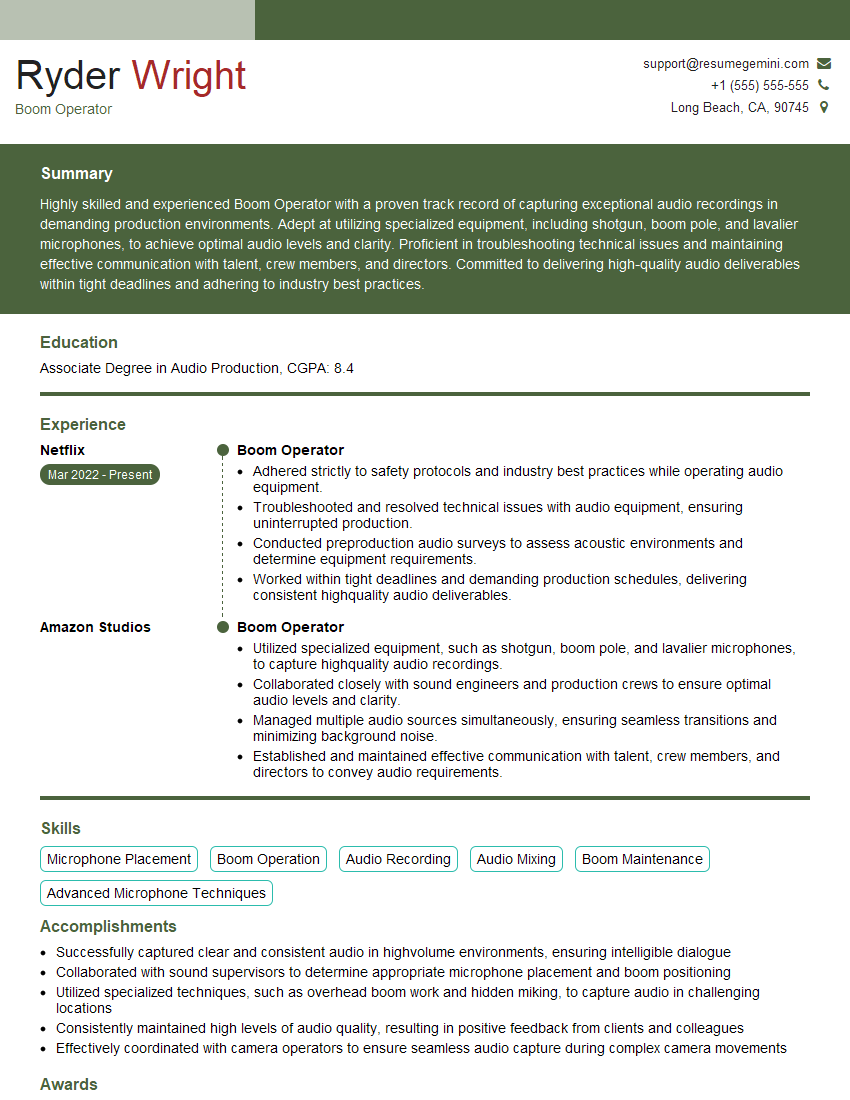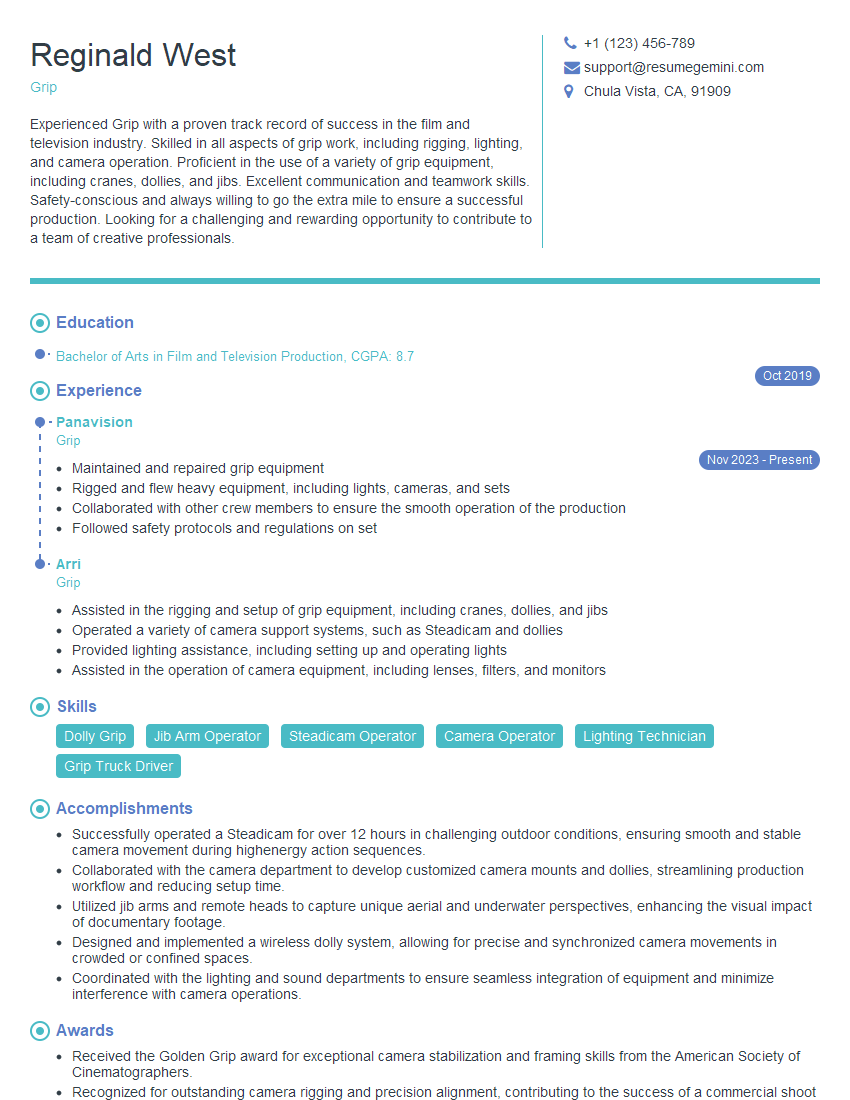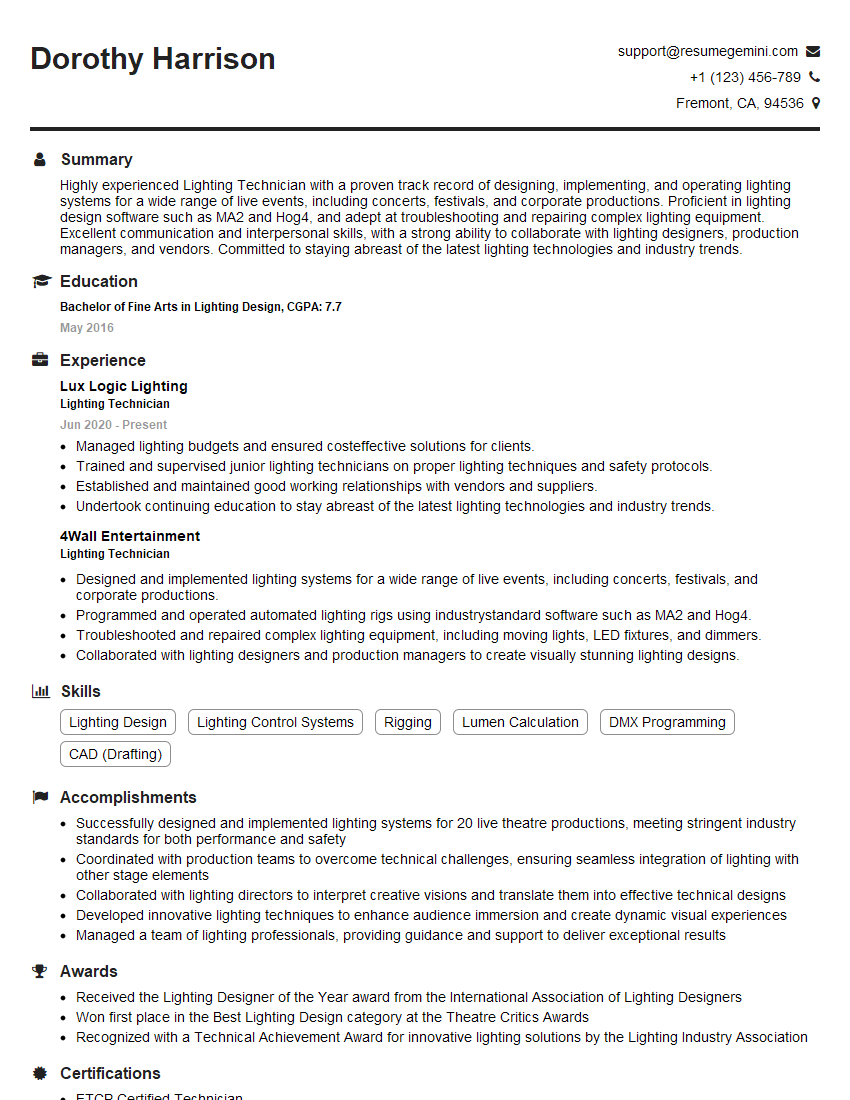Interviews are more than just a Q&A session—they’re a chance to prove your worth. This blog dives into essential Boom Arm Maneuverability interview questions and expert tips to help you align your answers with what hiring managers are looking for. Start preparing to shine!
Questions Asked in Boom Arm Maneuverability Interview
Q 1. Describe your experience operating a boom arm in various shooting environments.
My experience with boom arms spans diverse shooting environments, from cramped indoor sets to expansive outdoor locations. I’ve operated them in bustling city streets, quiet forests, and even on unstable platforms like boats. Each environment presents unique challenges. For instance, working in tight spaces requires meticulous planning and precise control to avoid collisions. Outdoor shoots necessitate careful consideration of wind and weather conditions, which can significantly impact boom arm stability and camera movement. In one memorable shoot on a riverbank, we had to account for the uneven terrain and potential for shifting ground under the boom arm’s base. This required using counterweights and securing the base exceptionally well. Adapting my techniques to these varied conditions has honed my skills in safe and effective boom arm operation.
Q 2. Explain the safety procedures you follow when operating a boom arm.
Safety is paramount when operating a boom arm. My standard procedure always begins with a thorough pre-operation check, verifying the stability of the base, the integrity of all cables and connections, and ensuring the counterweights are appropriately positioned. I always communicate clearly with the camera operator, ensuring we both understand the planned movements and potential risks. Before each movement, I confirm a clear area around the boom arm to prevent collisions with crew or equipment. I never operate a boom arm while under pressure or distracted. Furthermore, I strictly adhere to weight limits for the arm and payload, and I always ensure that the boom is properly locked when not in motion. In instances where working at height, I’ll always utilize appropriate safety harnesses and other personal protective equipment (PPE).
Q 3. How do you ensure smooth and precise camera movements with a boom arm?
Achieving smooth and precise camera movements with a boom arm demands a delicate balance of technique, equipment, and communication. The operator’s skill is vital; smooth movements are achieved through controlled, gradual adjustments, avoiding sudden jerks or jolts. Understanding the arm’s weight distribution and counterbalance is also essential. Properly calibrated counterweights minimize vibrations and allow for more delicate movements. Communication with the camera operator is key; clear instructions and a good understanding of each other’s intentions prevent mishaps. Using a fluid head on the camera allows for fine adjustments during movement, ensuring smooth pans, tilts, and tracking shots. Practicing different techniques and drills helps in achieving consistency. For example, rehearsing movements before the actual shoot allows for the fine-tuning of counterweights and operator technique.
Q 4. What are the different types of boom arms and their respective applications?
Boom arms vary significantly in size, weight capacity, and functionality. There are lightweight, manually operated booms suitable for smaller cameras and tighter spaces. Then there are larger, motorized booms used for heavier cameras and more dynamic shots, often controlled remotely. Jib arms, a specific type of boom arm, offer a longer reach and are often favored for dramatic aerial shots. Each type has its application; for instance, a lightweight boom is ideal for documentary work where portability is important, while a large, motorized boom is necessary for feature films requiring sweeping camera movements.
- Lightweight Manual Booms: Ideal for smaller cameras, documentaries, and portability.
- Heavy-duty Motorized Booms: Used for larger cameras, dynamic shots, and often remote control.
- Jib Arms: Long reach for dramatic overhead and aerial shots.
Q 5. How do you handle unexpected challenges or malfunctions during a boom arm operation?
Handling unexpected malfunctions requires a calm and methodical approach. My first step is to immediately stop the operation and assess the situation. If it’s a minor issue, like a loose cable, I can quickly address it. For more significant problems, like a malfunctioning motor or a compromised base, I will immediately consult with the team, potentially calling in a technician depending on the complexity of the issue. Safety is paramount, so if the issue compromises safety, the operation is halted immediately. In many instances, having a backup plan is crucial. During one shoot, the boom arm’s motor suddenly failed. Fortunately, we had a backup system — a lightweight manual boom — which allowed us to complete the shoot with minimal disruption, although with a slightly modified shot plan. Thorough equipment maintenance and regular checks are key to preventing many of these issues.
Q 6. Describe your experience with different boom arm control systems.
My experience encompasses various boom arm control systems, from simple manual operation to sophisticated computer-controlled systems. Manual operation requires precise hand-eye coordination and a good understanding of weight balance. Motorized booms can be controlled via joysticks, handwheels, or even computer software, allowing for fine-tuned movements and programmable shots. I’ve worked with systems offering different levels of precision and automation. Some systems allow for pre-programming of complex movements, reducing setup time and increasing efficiency. The choice of control system depends on the project’s scale, budget, and the desired level of camera control. Understanding the capabilities and limitations of each system is essential for effective operation.
Q 7. How do you maintain the balance and stability of a boom arm during operation?
Maintaining balance and stability is crucial for safe and smooth operation. This starts with properly adjusting the counterweights to match the camera and other equipment’s weight. The balance point needs to be carefully calculated. Uneven weight distribution can lead to instability and potentially dangerous situations. The boom’s base must be firmly planted on a stable surface. On uneven terrain, using a stabilizing base or sandbags can help. Wind conditions also significantly impact stability, especially with longer booms. In windy conditions, heavier counterweights might be needed, or the operation might need to be adjusted or even paused altogether. Regular checks of the counterweights and base stability throughout the operation are vital for maintaining balance and preventing accidents.
Q 8. How do you collaborate with other crew members during boom arm operation?
Effective boom arm operation relies heavily on teamwork. Before any movement, I always communicate clearly with the camera operator, the focus puller, and any other crew members in the vicinity. We establish hand signals or verbal cues for specific movements – ‘up,’ ‘down,’ ‘pan left,’ etc. – to ensure everyone understands and anticipates the arm’s trajectory. For example, before a complex shot involving a sweeping crane move, we’ll rehearse the planned movements, adjusting positions as needed to prevent collisions or obstructions. Clear communication prevents accidents and ensures smooth, coordinated camera movement.
During operation, maintaining constant visual contact is crucial. I’ll regularly check in with the camera operator to confirm the desired shot is being achieved. If adjustments are necessary, we’ll communicate swiftly and make corrections collaboratively. This collaborative approach leads to more efficient and safer shoots.
Q 9. What are the limitations of using a boom arm and how do you overcome them?
Boom arms, while versatile, have limitations. Reach is a primary constraint; there’s a finite distance the arm can extend. Weight capacity also plays a role, meaning heavier camera setups might require larger, more powerful booms. Finally, wind can significantly affect stability, especially at higher extensions. We mitigate these limitations in several ways. For limited reach, we may use multiple camera positions or employ other camera support systems to capture shots from different angles. For weight constraints, we select the appropriate boom for the camera package, optimizing for balance and stability. To overcome wind challenges, we use weighted counterbalances and may choose to shoot on calmer days or use stabilization techniques.
Q 10. How do you adapt your boom arm techniques to different camera sizes and weights?
Adapting to varying camera sizes and weights requires adjusting the counterbalance and understanding the arm’s load capacity. A heavier camera package needs a proportionally greater counterweight. Before operating, I carefully assess the total weight, including the camera, lens, accessories, and any additional rigging. I then adjust the counterweight to maintain balance and smooth operation, ensuring the boom isn’t excessively weighted on one side. This avoids strain on the arm mechanism and allows for precise, controlled movement. For smaller, lighter cameras, the process is similar but involves using a smaller counterweight, always maintaining a balanced state. I’ve worked with cameras ranging from small mirrorless systems to large cinema cameras, and adjusting the counterweight is the key to smooth operation in all cases.
Q 11. Explain the importance of counterweight balancing in boom arm operation.
Counterweight balancing is paramount for safe and smooth boom arm operation. It ensures the arm remains stable and easily maneuverable, preventing unexpected movement or jolts. An unbalanced boom is prone to uncontrolled swinging and can even lead to tipping or damage. Proper counterbalancing distributes the weight evenly, minimizing strain on the arm’s mechanical components. I always meticulously adjust the counterweight based on the camera package’s total weight and the arm’s extension, aiming for a system that is balanced but still responsive enough for smooth operation. Think of it like a seesaw – if the weights aren’t balanced, it’s difficult to control the movement.
Q 12. Describe your experience with jib arms and their differences compared to boom arms.
I have significant experience with both boom arms and jib arms. While both are used for dynamic camera movement, they differ in their design and operation. A boom arm typically uses a counterweight system for balance, offering flexibility in vertical and horizontal movement but often having limited reach compared to a jib. Jib arms, on the other hand, generally utilize a long arm that extends from a fixed point, providing greater reach for wide, sweeping shots. Their counterweight system is frequently integrated into the arm structure and is less adjustable than that of a boom. Jibs offer more dramatic perspectives, particularly in wide, sweeping shots. I’ve found booms to be more versatile for tighter spaces and more precise camera control, whereas jibs excel when capturing expansive scenes.
Q 13. How do you ensure the safety of the camera and crew during boom arm operation?
Safety is my top priority. Before each operation, I conduct a thorough inspection of the boom arm and its components, checking for any damage or loose parts. I also ensure the counterweight is properly adjusted and secured. Throughout the operation, I maintain constant awareness of the arm’s position and trajectory, avoiding any potential collisions with crew members, equipment, or obstacles. Safety zones are established, and clear communication is maintained with everyone on set. We use safety pins and locks where necessary, ensuring that the components are secure. Further, we never exceed the boom’s weight or reach limits. This methodical approach ensures the safety of both the equipment and the crew.
Q 14. What are some common mistakes to avoid when operating a boom arm?
Common mistakes include neglecting proper counterbalancing, leading to uncontrolled movements and potential damage. Overextending the boom beyond its capacity can cause instability and stress the arm’s mechanism. Another frequent error is poor communication with the camera operator, resulting in misaligned shots or collisions. Finally, failing to inspect the boom before use and disregarding safety procedures are major risks. I stress the importance of preventative maintenance and consistent adherence to safety guidelines to avoid these pitfalls. Careful planning, attention to detail, and continuous communication are key to preventing problems.
Q 15. Describe your experience with different types of camera mounts used with boom arms.
My experience encompasses a wide range of camera mounts used with boom arms, from simple friction-based mounts to sophisticated geared heads. I’ve worked extensively with:
- Fluid heads: These are essential for smooth, controlled camera movements. I prefer those with precise drag adjustment for different camera weights and desired movement speeds. For instance, I’ve used the OConnor 2575D extensively, appreciating its robustness and versatility.
- Geared heads: Offering incredibly precise control, geared heads are crucial for complex shots requiring minute adjustments. I’ve used these successfully in situations demanding perfect framing, such as time-lapses or shots needing precise tracking.
- Gimbal heads: These are increasingly common, particularly for smoother handheld or stabilized boom shots. I’ve utilized them in situations where minimizing vibration was paramount, like aerial shots or shots involving delicate equipment.
The choice of mount heavily depends on the specific shot, camera weight, and desired movement style. The understanding of each mount’s capabilities is crucial for efficient and creative camera operation.
Career Expert Tips:
- Ace those interviews! Prepare effectively by reviewing the Top 50 Most Common Interview Questions on ResumeGemini.
- Navigate your job search with confidence! Explore a wide range of Career Tips on ResumeGemini. Learn about common challenges and recommendations to overcome them.
- Craft the perfect resume! Master the Art of Resume Writing with ResumeGemini’s guide. Showcase your unique qualifications and achievements effectively.
- Don’t miss out on holiday savings! Build your dream resume with ResumeGemini’s ATS optimized templates.
Q 16. How do you plan and execute complex camera movements using a boom arm?
Planning complex camera movements involves meticulous pre-visualization and rehearsal. It starts with a thorough understanding of the director’s vision. I often create storyboards or even simple sketches to visualize the path of the boom arm and the resulting shot.
Execution involves:
- Precise measurement and marking: I carefully mark the boom arm’s base and swing points to ensure consistent and repeatable movements. This is particularly important for complex sequences.
- Careful weight distribution: Balancing the camera and mount on the boom is crucial to prevent unwanted movement or strain on the arm. This often involves counterweights or adjustments to the boom’s center of gravity.
- Incremental movement: For complex movements, I break down the shot into smaller, manageable segments. This allows for precise control and minimizes errors.
- Communication and Collaboration: Constant communication with the camera operator and director is key. I ensure that everyone is on the same page regarding timing, speed, and the desired camera position.
For example, in a recent shoot, we needed a slow, arcing shot across a vast landscape. Through careful pre-planning and incremental adjustments, we achieved a smooth, flowing movement that enhanced the scene’s grandeur significantly.
Q 17. How do you adjust your boom arm operation based on the director’s vision?
Adapting to the director’s vision is paramount. I actively listen to their descriptions, visual references (storyboards, film stills), and even their emotional intent for the scene.
My approach involves:
- Active Listening and Clarification: I ensure I understand the director’s vision completely, asking clarifying questions to eliminate ambiguity.
- Trial and Error: Often, we’ll try out various boom arm positions and camera angles, iterating until we achieve the desired look. This collaborative process often leads to even better results than initially imagined.
- Technical Expertise: I use my knowledge of camera movement, boom arm mechanics, and the capabilities of different mounts to suggest technically feasible options that align with the director’s artistic intent. For example, if they desire a specific sense of unease, I might utilize a slow, deliberate, and slightly unsteady boom movement.
- Flexibility and Adaptability: Set conditions, lighting, and unforeseen circumstances often require creative adjustments. I’m adept at finding workable solutions while preserving the core elements of the director’s vision.
Ultimately, my goal is to translate the director’s artistic vision into a flawless camera movement using the boom arm.
Q 18. Explain your experience with different types of cables and their impact on boom arm operation.
Cable management is critical for smooth boom arm operation. Different cables have varying weights, flexibilities, and propensities to tangle. My experience includes:
- Fiber optic cables: Excellent for long runs and high-bandwidth applications, they’re lightweight but require careful handling to avoid breakage.
- Coaxial cables: Common for video and power transmission, they can be heavier and more prone to tangling, necessitating proper cable management systems.
- Multi-core cables: These often bundle power, video, and audio signals, requiring attention to their weight distribution and routing to prevent snags or pulls on the boom arm.
Using appropriate cable management techniques, such as cable wraps, clips, and dedicated cable trays, prevents tangling, minimizes strain on the boom arm, and eliminates unwanted cable noise or interference in the camera signal.
In practice, I always assess the type and length of cables needed before a shoot and plan the routing to avoid any issues during operation. A poorly managed cable can easily ruin a complex shot.
Q 19. How do you troubleshoot common problems related to boom arm operation?
Troubleshooting boom arm issues requires a systematic approach. I begin by identifying the symptoms:
- Unbalanced Movement: This could indicate uneven weight distribution, loose parts, or a malfunctioning counterweight system. I start by checking all connections and ensuring the camera and mount are correctly balanced.
- Stiff or Jerky Movement: Possible causes include insufficient lubrication, worn-out bearings, or damaged cables. I would systematically inspect each component, testing for smoothness of operation at each joint.
- Creaking or Grinding Noises: This points to a lack of lubrication or worn-out parts. I would lubricate moving parts with the appropriate lubricant and replace any worn components.
- Sudden Dropping or Instability: This could signal a critical failure, like a broken cable, clamp, or structural component. In this case, I’d immediately halt operations and perform a thorough safety inspection before proceeding.
If the problem persists, I consult the boom arm’s manual, reach out to technical support, or call in a qualified technician. Preventing issues through regular maintenance is far more efficient than troubleshooting them during a critical shoot.
Q 20. What are your methods for ensuring a smooth and quiet operation of the boom arm?
Smooth and quiet operation is paramount. My methods focus on:
- Proper Lubrication: Regular lubrication of moving parts using high-quality lubricants minimizes friction and noise. I follow manufacturer recommendations for lubricant type and application.
- Cable Management: As previously mentioned, proper cable management minimizes cable noise and prevents snags or pulls that could introduce unwanted movement.
- Careful Movement Techniques: Smooth, controlled movements using the correct counterweights minimize vibrations and sudden jerks. I employ incremental movements to create seamless transitions.
- Isolation Techniques: In cases of extreme sensitivity to vibration, we employ techniques like isolating the boom arm base from the ground using dampening materials or vibration isolators.
The quality of the boom arm itself also plays a significant role. High-quality, well-maintained equipment is less prone to noise and unwanted movements.
Q 21. How do you maintain the cleanliness and proper functionality of a boom arm?
Maintaining a boom arm involves regular cleaning and inspections to ensure functionality and longevity.
- Regular Cleaning: I regularly clean the boom arm with a soft cloth and appropriate cleaning solutions, paying attention to removing dust, dirt, and debris from moving parts. I avoid harsh chemicals that could damage the equipment.
- Component Inspections: I regularly inspect cables for fraying or damage, check for loose screws or bolts, and lubricate moving parts as needed. Regular visual inspection can catch minor problems before they escalate into major issues.
- Storage: When not in use, I store the boom arm in a protective case or cover to prevent damage from dust, moisture, or accidental impacts.
- Professional Maintenance: Depending on usage, I schedule periodic professional maintenance to ensure the boom arm is functioning optimally and to address any potential issues proactively.
Proactive maintenance is crucial for maximizing the lifespan and reliability of the boom arm. A well-maintained boom arm ensures consistent performance and reduces the risk of costly repairs or equipment failure during a critical production.
Q 22. Describe your knowledge of different types of boom arm accessories.
Boom arm accessories significantly enhance functionality and versatility. They range from simple additions that improve cable management to more complex components that expand shooting capabilities.
- Counterweights: These are crucial for balancing the boom arm and camera payload, ensuring smooth and controlled movements. Improper counterweighting can lead to instability and potential damage.
- Cable Clamps and Wraps: These keep cables organized and prevent tangling, which is vital for safety and efficient operation. I always use multiple clamps and wraps to secure cables at various points along the boom arm.
- Microphone Mounts: These allow for the precise placement of microphones close to the subject while maintaining a clean aesthetic. I’ve found that flexible gooseneck mounts provide the most versatility.
- Monitor Mounts: These accessories extend the ability to view the camera feed from different angles, aiding in both framing and focus. They are essential for remote camera operation.
- Extension Arms: Some boom arms allow for extending the reach of the boom itself, significantly impacting shot possibilities. Understanding the weight limits when using extensions is critical.
The choice of accessories depends entirely on the specific production needs and the type of boom arm being used. I always assess the requirements beforehand and select the accessories that optimize performance and safety.
Q 23. Explain your understanding of weight limits and center of gravity concerning boom arm operation.
Understanding weight limits and center of gravity is paramount for safe and effective boom arm operation. Exceeding weight limits can lead to catastrophic equipment failure and potential injury. Center of gravity affects the balance and stability of the entire setup.
Imagine a seesaw: The camera and its accessories are on one side, and the counterweights are on the other. The center of gravity needs to be balanced to prevent tipping. If the camera payload is too heavy or improperly positioned (affecting the center of gravity), the arm can become unstable, potentially leading to a crash.
I always meticulously calculate the total weight of the camera, lens, accessories, and any additional equipment before operation. I then adjust the counterweights to ensure perfect balance. Regular checks throughout the shoot are essential, as adjustments may be necessary during operation, particularly if the lens is zoomed or equipment is changed.
Manufacturers provide detailed specifications including weight limits. Never exceed those limits. Safety should always come first.
Q 24. How do you manage cable management to avoid tripping hazards and tangles?
Cable management is crucial for preventing tripping hazards and tangles, ensuring both safety and a professional-looking setup. A tangled mess of cables not only looks unprofessional but also poses a serious risk of accidents.
My approach involves a multi-step process:
- Pre-planning: Before setting up the boom arm, I plan the cable routing, minimizing the length and ensuring clear pathways. I often use cable ties and velcro straps to bundle cables together.
- Strategic Placement: I position the cables along the boom arm, running them neatly along its length, and securing them with appropriate clips or straps. I avoid letting them dangle or loop.
- Floor Management: On the floor, I use cable protectors to prevent tripping. I also try to route cables under furniture or other objects to keep them out of the way.
- Regular Checks: Throughout the shoot, I regularly check the cable management to ensure nothing has shifted or become tangled. A quick visual inspection takes only a few seconds but can prevent accidents.
Efficient cable management is not just about safety; it streamlines the workflow and helps maintain a professional environment on set.
Q 25. What safety measures do you take to prevent damage to the equipment or set?
Preventing damage to equipment and the set demands a proactive and meticulous approach. My safety measures include:
- Thorough Inspection: Before each use, I inspect the boom arm and all accessories for any signs of damage or wear and tear. This includes checking for loose screws, damaged cables, and any other potential issues.
- Proper Weight Distribution: As mentioned earlier, carefully calculating and maintaining proper weight distribution is key to preventing strain and damage to the boom arm.
- Controlled Movements: I always operate the boom arm smoothly and deliberately, avoiding jerky or abrupt movements that could put stress on the equipment or cause it to collide with objects.
- Environmental Awareness: I’m always mindful of the surroundings. I check for obstructions before extending the boom and ensure there’s enough clearance for any movements.
- Regular Maintenance: Regular lubrication and maintenance of the boom arm are crucial in maintaining its longevity and preventing premature failure.
By adhering to these measures, I minimize the risk of equipment damage and ensure a safe and efficient workflow.
Q 26. How do you communicate effectively with the camera operator during boom arm operation?
Effective communication with the camera operator is essential for seamless boom arm operation. Clear and concise communication prevents misunderstandings and ensures both parties are on the same page.
I use a combination of verbal and non-verbal cues:
- Clear Terminology: I use precise terminology to avoid ambiguity. For example, rather than saying “move it a little,” I’d say “pan slightly to the left.”
- Hand Signals: Hand signals are particularly useful in noisy environments. We establish pre-agreed signals for specific movements (e.g., stop, tilt up, tilt down).
- Intercom System: On larger productions, I rely on an intercom system for clear, immediate communication. This ensures efficient collaboration, particularly in complex shots.
- Regular Check-Ins: Throughout the shot, I regularly check in with the camera operator to ensure the framing is correct and the operator is comfortable.
Open communication fosters a collaborative environment, enabling us to smoothly execute complex camera movements with precision and efficiency.
Q 27. Describe your experience with remote-controlled boom arms.
My experience with remote-controlled boom arms has been extensive and rewarding. They offer incredible flexibility and control, allowing for complex camera movements that would be impossible with manual operation.
I’m proficient in operating various brands and models, understanding the nuances of their control interfaces and software. This includes configuring parameters such as speed limits, acceleration curves, and preset positions. I am familiar with troubleshooting potential connectivity issues and overcoming any limitations inherent in the specific system.
Remote-controlled boom arms are particularly useful in situations where access to the boom arm itself is limited or where precision is critical, such as working with delicate equipment or in tight spaces. The ability to operate the arm from a distance significantly improves workflow and can reduce the risk of accidents.
The key to successful remote operation is a thorough understanding of the control system and the ability to anticipate the boom arm’s behavior. Regular practice and a keen eye are crucial for mastering these tools effectively.
Q 28. Explain your understanding of the different types of boom arm movements (e.g., pans, tilts, arcs).
Boom arm movements are fundamental to cinematography, offering dynamic and expressive camera angles. Understanding the different types and their application is crucial for effective storytelling.
- Pan: A horizontal rotation of the camera. Think of sweeping across a landscape.
- Tilt: A vertical rotation of the camera. This creates a dynamic effect like looking up at a tall building or down into a canyon.
- Arc: A combination of pan and tilt, creating a smooth curved motion. This is great for following a subject as they move across the frame.
- Pedestal: Raising or lowering the entire boom arm, providing different perspectives or levels.
- Zoom: Although not a boom arm movement itself, it’s often used in conjunction with boom arm movements to adjust the framing and perspective.
Mastering these movements allows for dynamic and expressive shots that can enhance a scene and provide a more immersive viewer experience. I consistently practice each movement, honing my ability to smoothly and precisely execute complex combinations.
Key Topics to Learn for Boom Arm Maneuverability Interview
- Understanding Boom Arm Mechanics: Explore the fundamental principles of hydraulics, pneumatics, or electric systems driving boom arm movement. Analyze force vectors and leverage points influencing maneuverability.
- Safety Procedures and Regulations: Review all relevant safety protocols, emergency shutdown procedures, and industry regulations concerning boom arm operation. Understand load limits, stability calculations, and risk mitigation strategies.
- Calibration and Maintenance: Learn about routine inspection, calibration techniques, and preventative maintenance practices for optimal boom arm performance. Familiarize yourself with troubleshooting common malfunctions and sensor calibration.
- Software and Control Systems: If applicable to the role, gain proficiency in the software or control systems used to operate and program the boom arm’s movements. This might include understanding control algorithms, programming languages, or human-machine interfaces.
- Practical Applications and Use Cases: Consider various real-world applications of boom arms in different industries (e.g., construction, manufacturing, film). Think about how different scenarios might require adjustments in operation techniques and safety measures.
- Problem-Solving and Troubleshooting: Practice diagnosing and resolving common issues related to boom arm functionality. Develop your ability to identify potential problems, assess their impact, and implement effective solutions.
- Advanced Maneuvering Techniques: Research and understand advanced techniques such as precise positioning, complex movements, and working in challenging environments (e.g., confined spaces, inclement weather).
Next Steps
Mastering boom arm maneuverability opens doors to exciting career opportunities in diverse fields, offering strong earning potential and professional growth. To maximize your job prospects, crafting a compelling and ATS-friendly resume is crucial. ResumeGemini is a trusted resource that can help you build a professional resume that showcases your skills and experience effectively. We provide examples of resumes tailored to Boom Arm Maneuverability to help you get started. Invest time in crafting a strong resume to present your qualifications in the best possible light and increase your chances of landing your dream job.
Explore more articles
Users Rating of Our Blogs
Share Your Experience
We value your feedback! Please rate our content and share your thoughts (optional).
What Readers Say About Our Blog
good
